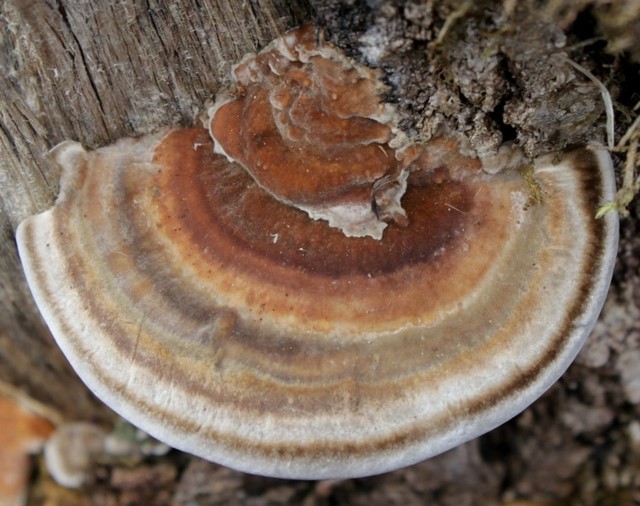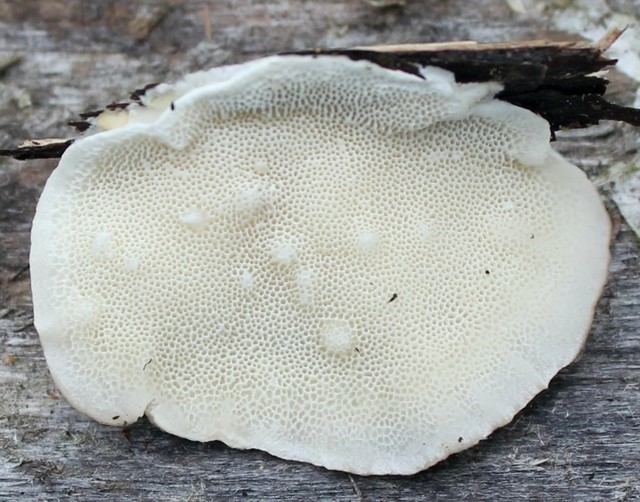Content
Stekherinum Murashkinsky (lat. Metuloidea murashkinskyi) or irpex Murashkinsky is a medium-sized mushroom with a rather unusual appearance. Its fruiting body is not clearly shaped, and its cap resembles a large oyster shell. It got its name in honor of the Soviet scientist, professor of the Siberian Agricultural Academy K. E. Murashkinsky.
Description Stekherinum Murashkinsky
The hat has the shape of a semicircle, which can reach 5-7 cm in diameter. Its thickness is about 1 cm. This type is rarely found alone. Most often, you can find groups of mushrooms that are located close to each other like shingles.
Fresh hats of this species are leathery and elastic to the touch. They become brittle as they dry. The surface is slightly pubescent, especially in young specimens. The older the fruiting body, the smoother its cap. The color varies from whitish with an admixture of ocher to pinkish-brown shades. As the cap develops, it darkens.
The hymenophore belongs to the spiny type - it consists of many small cone-shaped spines, the length of which does not exceed 4-5 mm. The closer they are to the edge of the cap, the smaller their size. In color, they can be cream or reddish brown depending on age.
The leg is absent as such, as it is a sedentary species. The base of the cap is slightly narrowed at the point where the fruiting body is attached to the support.
Where and how it grows
The distribution area of Murashkinsky's stekherinum is quite extensive - it grows in China, Korea, and also Europe (it is found in large quantities in Slovakia). On the territory of Russia, this variety can most often be found in Western Siberia, the Far East and the Caucasus. Small groups of mushrooms are also found in the European part of the country.
Irpex of various species prefers to settle on dead wood, and usually these are deciduous trees. In southern Russia, fruit bodies are most often found on oak, aspen and birch. In the Northern regions, Murashkinsky's stekkherinum lives on fallen willow trunks. The likelihood of finding the fungus in moist deciduous and mixed forests, especially in areas with dead wood, is significantly increased.
It bears fruit actively in August and September, but it is not common. In spring, overwintered and dried fruit bodies of this species can sometimes be found.
Is the mushroom edible or not
Irpeks Murashkinsky is classified as an inedible variety. Its pulp does not contain toxic substances, however, the fruit body is too tough. Even after heat treatment, it is not edible.
Doubles and their differences
Antrodiella odorous (lat.Antrodiella fragrans) - one of the few twins. Has a similar aniseed scent.Outwardly, the mushroom is very similar to Murashkinsky's stekherinum. This twin is distinguished by the hymenophore, which has a porous structure, and not a spiny one.
The peak of fruiting occurs in late August - early September. Most often it is possible to find odorous anthrodiella on dead trunks. Fruit bodies are unsuitable for consumption.
Ocher trametes (lat.Trametes ochracea) is another twin of Murashkinsky's stekherinum. In general, it is slightly smaller, however, young mushrooms are difficult to distinguish by this parameter. The shape of the cap in these species is almost identical; the trameteos also grows in a group, but most often on stumps.
The color of the ocher trametess is very diverse. Fruit bodies can be colored in both delicate cream tones and gray-brown shades. Sometimes there are specimens with orange caps. Such fruiting bodies can be easily distinguished from Steckherinum, which is never so brightly colored.
They are distinguished by a double on the lower surface of the cap - it is milky white, sometimes creamy. The hymenophore of the trametess is porous. Also, these two types can be distinguished by their smell. Murashkinsky's stekherinum has a pronounced aniseed aroma, while ocher tramese smells like fresh fish.
Ochreous trametes does not contain toxic substances, however, the structure of its pulp is quite tough. For this reason, the variety is considered inedible.
Conclusion
Murashkinsky's Stekherinum is a rather unusual-looking mushroom that resembles a large shell. It is not classified as poisonous, however, due to its tough pulp, it is still not eaten.












